| Family DRYOPTERIDACEAE: Wood Ferns Not quite xerophytes, but often found growing with them in sheltered areas. | |
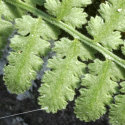 |
Woodsia
neomexicana New Mexico Woodfern
Leaves light green, thin and fragile looking, bipinnate. Pinnae long and triangular but bluntly rounded, with finely toothed margins and no cilia. Damp shade among rocks. SIMILAR SPECIES: Other Woodsia have more coarsely toothed leaflets. W. phillipsii has more elongate pinnae and tiny whitish "fringes" on the edges of the leaflets. |
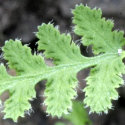 |
Woodsia phillipsii
Fringed Woodfern
Leaves light green, bipinnate, pinnae long and pointed, with thickened margins and cilia (tiny white or transparent hairlike "fringes") on toothed edges. Indusia (partial coverings on sori) are narrow and fringelike. Damp, shady rock ledges on granite or volcanics. SIMILAR SPECIES: Other Woodsia do not have cilia on leaf edges or fringelike indusia. They have fewer pinnules and the pinnae are blunt, not elongate. |
| Family PTERIDACEAE: True Ferns Large, diverse family that includes the true xerophytes. 37 species in West Texas. | |
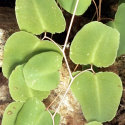 |
*Pellaea
ovata Zig-Zag Cliffbrake
Smooth, oval leaflets on pale wiry zig-zag stem. SIMILAR SPECIES: P. intermedia also has oval leaflets, but the stem is straight, not zig-zag, and leaflets are more nearly circular. P. truncata has straight stems and leaflets are tipped with a tiny spine. P. cordifolia has a straighter stem and the leaflets are larger and more heart-shaped. |
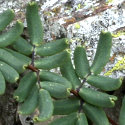 |
Pellaea
ternifolia & Pellaea wrightiana
These two species are very similar and are shown together for easy comparison. Both have long, narrow leaves with narrow, smooth, dark green leathery leaflets that are ternate (divided into threes). P. wrightiana has the lowest leaflets pinnate (five or more subleaflets) rather than ternate. In P. ternifolia, the lowest leaflets are ternate. SIMILAR SPECIES: No other Southwestern fern has ternate leaflets. Both are variable in size and leaflet shape. |
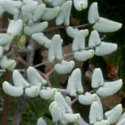 |
*Argyrochosma
microphylla Littleleaf Silver Fern
Leaves lacy looking, pale bluish green or grayish green, bipinnate to tripinnate. Leaflets tiny, oval to rounded-triangular, smooth on both sides and without scales, hair, or farina. SIMILAR SPECIES: Pellaea species within the same range have larger leaflets that are dark green, not light bluish green. A. limitanea ssp. mexicana has smaller leaves with larger oval leaflets. ADDITIONAL PHOTO: Another view of A. microphylla, growing with Selaginella lepidophylla. |
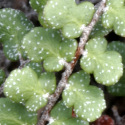 |
Astrolepis
cochisensis ssp. chihuahuensis
Leaves narrow, pinnate, with rounded leaflets that have two or three lobes each. Upper side dusted with white star-shaped scales; underside densely covered in triangular tan to brownish scales. Full sun on limestone. This subspecies is not reported to be distinguishable in the field from A. c. cochisensis. SIMILAR SPECIES: A. integerrima has more elongate leaflets and a thicker coating of scales. See the Arizona Xerophytic Ferns page for detailed comparison of all U.S. Astrolepis species. |
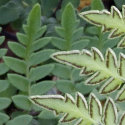 |
Cheilanthes
alabamensis
Shown in the Arizona fern guide, but included here for better photos. Triangular bright green leaves, tripinnate, smooth on both sides, without scales or hairs. Pinnae may be alternate. Leaflets triangular, long pointed. SIMILAR SPECIES: C. wrightii is smaller, usually lighter green, with bluntly pointed leaflets. C. tomentosa has smaller, more rounded leaflet segments and has at least some hair or fuzz on the leaves. Notholaena grayi is smaller and has a white waxy coating on the underside of the leaves. |
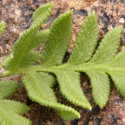 |
*Cheilanthes
horridula
Leaves triangular, light to dark green, bipinnate or pinnate-pinnatifid, covered with individually distinct, enlarged prickly-looking hairs. Leaflets and subleaflets strongly pointed. SIMILAR SPECIES: No other fern in its range has "prickles". C. alabamensis has smooth leaves. |
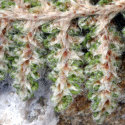 |
Cheilanthes
villosa
A very hairy and scaly "bead fern". Leaves triangular, tripinnate, with beadlike leaflet segments. Upper side of leaflets thickly covered with white curly hair. Veins on underside of leaflets covered with broad overlapping white or tan scales, each with a brown stripe. These scales are so large that the tips are often visible from the upper side of the leaf. SIMILAR SPECIES: See the Arizona Xerophytic Ferns page for discussion of similar "bead ferns" that are not as hairy or scaly as C. villosa. |
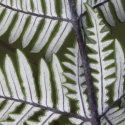 |
*Notholaena
copelandii
Short, broad leaves are almost (but not quite) star-shaped. Mostly bipinnate, leaflets long and narrow, bright white underneath due to heavy farina coating. On limestone. SIMILAR SPECIES: N. standleyi has pseudopentagonal (star-shaped) leaves. N. neglecta has more finely dissected leaves and smaller leaflet segments. |
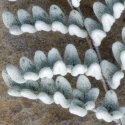 |
*Notholaena
greggii
Leaves long and narrow, bipinnate (tripinnate on lower leaflets), dark green with dense white glandular coating on the upper side. Underside of leaflets coated with white farina. Leaflets small, bluntly triangular. Restricted to limestone outcrops in the Big Bend region of Texas. SIMILAR SPECIES: N. neglecta has shorter, broader leaves. N. nealleyi, N. grayi, N. neglecta, and N. aliena lack the glandular coating on the upper surface. |